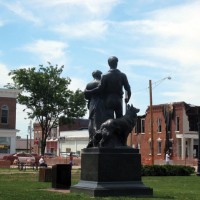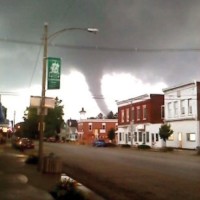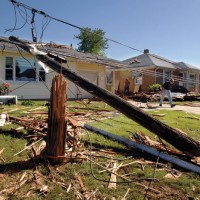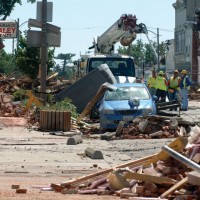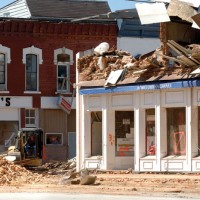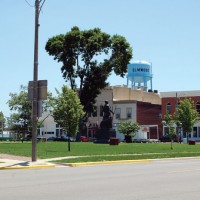Voices
After the Storm
- Details
- Published on Thursday, 01 March 2012 15:59
- Written by Kevin Kizer
A city on the grow
Who bridged the streams, subdued the soil and founded a state - plaque on the "The Pioneers" in Elmwood Central Park.
If you go to Central Park in the center square of Elmwood and stand before the statue entitled "The Pioneers" you're immediately struck by two things. First, the delicate fluidity and exquisite rendering of Western pioneers created by native son and noted sculptor Lorado Taft. The second striking thing occurs when you look just beyond the statue and realize this side of the otherwise heavily wooded park is relatively devoid of trees. That's because it's here where one of the two tornadoes that scoured the city on the night of Saturday, June 5, 2010, touched down, devastating half of the city park and uprooting century old trees, along with buildings on an adjacent street corner.
Amazingly, after the tornadoes left that night, not one person was killed and "The Pioneers" were still standing strong – which is something the city itself has done since that destructive night.
For someone who grew up in Indiana and has driven through many a small town, Elmwood is a wonderful example of what I consider small town America at its best.
Founded in 1854, the city to this day retains much of the architectural splendor and quaintness of that era. There are beautiful gabled houses on sprawling green lawns. Take a turn off the main streets through town and you'll find quiet neighborhoods under canopies of ancient trees (indeed, many of them of the Elm variety) where you will see children playing, folks taking walks (and quick to chat with a stranger with a notepad), runners hitting the pavement and quite a few docile black and yellow Labrador retrievers greeting you at the edge of their yards (either by training or electronic fence) obviously used to neighbors giving them a friendly pat.
One yellow Lab in particular was quite insistent, howling in shock and dismay at my passing without the requisite attention. I pivoted and quickly rectified the situation with a pat and apology and the Lab trotted back contentedly to the driveway from where it had been lying prior to my arrival. That, my friends, is Elmwood.
But beyond the emotional pull, Elmwood is a real city. It's not a satellite community or a drive-by town on some lonesome highway. It's a complete community with a police force, fire department and medical facilities. The downtown storefronts, many featuring 19th century architectural styles and designs, are home to banks, restaurants, corner shops, insurance agents, veterinarians, dentists and a hardware store to name a few. The charm even extends to the Palace Theater, which shows only one movie at a time ("We Bought A Zoo" at the time of writing, for $4 for any show). And there is particular pride in the high school, which has won multiple Bright Star awards and is ranked in the top 5 percent of schools in the state, and its sports teams (go Trojans!).
While I've been to Elmwood many times, especially after the tornadoes on that fateful night, and met many people, to find out more about the city I went where any self-respecting writer would go – the local library (you thought I was going to write "bar", didn't you?). On a bright, quiet Tuesday afternoon I stepped into the freshly renovated library and did what I always do around aisles of books – got lost in them.
After wading through the volumes for a half an hour – featuring modern genre writers as well as classics from Faulkner, Fitzgerald and Hemingway – I asked to see a librarian to talk about the city, the tornado and the aftermath.
Along with being a librarian at the Morrison and Mary Wiley Library, Michelle Armbruster is a lifelong Elmwood resident. She said the weekend when the tornadoes struck was an exciting one: it was the weekend of the annual Strawberry Festival, which the city has been hosting for 23 years. When they heard the storm was on its way Michelle and her family did what they always do during "tornado season": they went to their basement for protection. After the storm passed and the family returned upstairs, they knew something serious had happened as part of their roof was heavily damaged. They left their home, which is only two blocks from the city's Central Park, and began walking to the center of town. Devastation greeted them every step of the way, along with neighbors who had weathered the storm (again, not one person was killed).
"For two blocks all we saw were bricks and tree limbs and glass," said Michelle. Talking about that night now, a year and a half later, still brings strong emotions to the surface. "We were stopping and hugging neighbors, just so happy to see that everyone was okay."
Obviously, not the same could be said for many buildings in the city. After passing through the park, Michelle proceeded to the library quite worried – and for good reason. The façade consists of two stories of gleaming glass windows that bath the library with a warm light. Those windows were on Michelle's mind too.
"With all those windows, who knew how much damage there would be," said Michelle. Luckily, the windows were unscathed. Michelle was shocked. It turned out an upper window in the building had been accidentally left slightly open. This, Michelle was told, was the probably the reason the windows remained intact.
After seeing that the library exterior was in good shape, Michelle continued a couple blocks further to her father's home (the home she grew up in). He was safe and the home undamaged.
After the tornadoes damaged the park and destroyed several neighboring buildings, including city hall, the next day the county requested to use the library as headquarters for the clean-up efforts. When Michelle opened the library and entered for the first time she realized it hadn't escaped the tornado's wrath completely. Part of the roof was damaged, allowing water to seep into the library. But again, Michelle was able to breathe a sigh of relief: only one book was damaged (and on the drive home, I was kicking myself for not asking what that book title was).
Since then the library and much of the town is back to normal and even better than before. The library roof was repaired and new flooring was installed. It also was re-plastered and re-painted from top to bottom. Indeed, as we sat at one of the library's study tables talking, I was struck by how new and fresh everything feels, with the bright January afternoon sun streaming in through the bank of windows.
Many of the destroyed buildings have been rebuilt, but one in particular that can't be rebuilt sticks in Michelle's mind: the hardware store that was more than 100 years old. It was not spared by the tornadoes. "It's really wonderful to see how everyone pulled together. That's why I've always wanted to live here," Michelle said. "But it's so sad to drive down that street and look over and realize that hardware store isn't there anymore."
The city has not only pulled together, it has taken the disaster as an opportunity to make improvements, especially on the technological side.
The schools have equipped students with laptops and instant responder systems – handheld controllers that allow them to respond to questions posed in class. Teachers use document cameras that can project whatever they are showing – say the dissection of a small object – on screen so students can watch from their desks. Teachers also use wireless tablets that act like smart boards, showing whatever it is they are writing on screen for the entire class to see.
Along with building new businesses and improving technology throughout the city, there also will be a downtown beautification project in 2012 thanks to government grants.
After touring the downtown and the neighborhoods, the schools and the city library, the restaurants and, okay, a bar (shout out to Woppers!), I returned to "The Pioneers" and saw something else about the sculpture: the firm gaze of the pioneers (including their big dog) staring off in the direction from which the tornadoes came that dark June night nearly two years ago. "The Pioneers" stared down those tornadoes and, just like the historic small town it celebrates, are standing strong today.















































